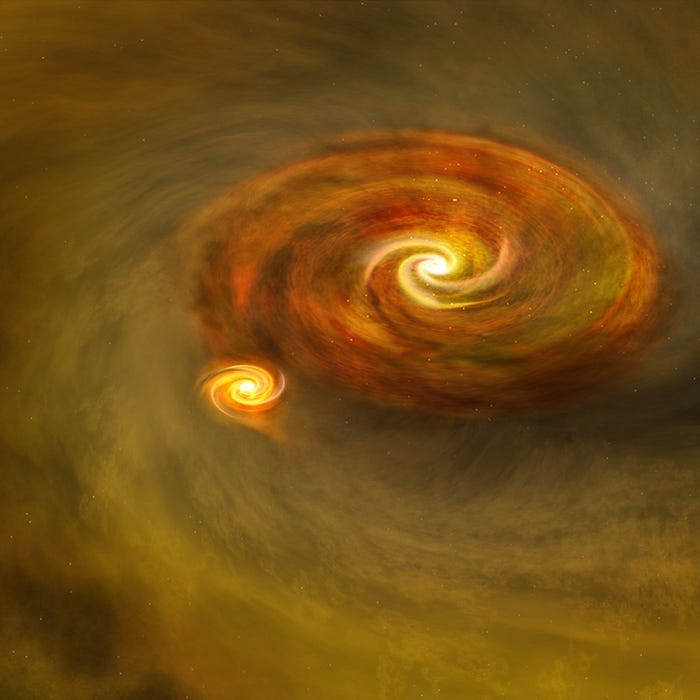
Twin stars are often born in the delivery room of giant molecular clouds. A common mechanism to create a pair of stars involves the collapse of a rotating gas cloud into a rapidly spinning disk. The self-gravity of a thin disk creates a dumbbell structure that deposits the angular momentum of the disk into two centers of gravity that accrete gas and could make a pair of stars. About half of the Sun-like stars have a companion of comparable mass. However, the Sun was a loner throughout its known history.
One of the unexpected discoveries of the Webb Telescope is Little Red Dots (LRDs). These compact red galaxies were discovered in the delivery room of the early universe, less than a billion years after the Big Bang. They are redder than expected from their cosmological redshift, indicating additional reddening by a veil of dust and gas. Some LRDs contain as much mass in evolved stars as our own Milky-Way galaxy, but are a hundred times smaller in radius, of order a few hundred light years. As I pointed out in a recent research note, the formation of unusually compact galactic disks was predicted in a paper I wrote with my former PhD student, Daniel Eisenstein, exactly thirty years ago
The number of stars per unit volume in LRD disks is a million larger than in the vicinity of the Sun. If a black hole had not already formed at the core of an LRD, it will inevitably form as a result of collisions among these stars. One way or another, the outcome would be a very compact gas disk. If the analogy to the formation of twin stars holds, compact LRD disks could lead to a dumbbell structure that give birth to supermassive black hole twins.
The existence of a compact disk in LRDs is supported by spectroscopic detection of broad emission lines, representing rotation of gas with a speed of up to a percent of the speed of light, thousands of kilometers per second, as expected for the birth sites of black holes. No X-rays were detected as of yet from these galaxies, as typically observed from quasars, but this emission might be hidden behind a thick blanket of gas. The required mass of the black hole is above expectations based on the correlation between the mass in stars and black holes in the present-day universe. LRDs might be pregnant with over-massive black hole twins in their bellies.
The formation of each black hole might go through a phase of a supermassive star, a giant ball of hot and dense gas with thousands to millions of solar masses. We have never observed supermassive stars in the local universe, but there are hints for their existence from pair-instability supernovae or intermediate-mass black holes that represent their end state.
Within LRDs, the orbital motion of two black holes would create effectively a “gravitational blender” that grinds stars and gas and shoves mass towards the center of the galaxy, more than a single black hole could. This naturally leads to the emergence of over-massive black holes.
Like Siamese twins, a pair of black holes that are too close to each other at birth would merge into one. In the black hole case, this merger would be driven by dynamical friction on the background gas at large separations and by the emission of gravitational waves as the pair tightens. The end result of such a merger would be a single over-massive black hole.
Black hole twins might also form during the collapse of a rotating core inside a normal massive star. As I pointed in a paper, the jets produced by the black holes could lead to a gamma-ray burst accompanying a gravitational wave signal, detectable by the gravitational wave network LIGO-Virgo-KAGRA.
The gravitational wave signal from the formation of supermassive black hole twins could be detected by the Laser Interferometer Space Antenna (LISA), planned for launch by ESO and NASA in 2035. Just like ultrasound imaging of twins in the belly of their mother, gravitational waves would inform us of the masses and separation of a newly born pair of black holes buried inside a red dot in the sky.
The birth of supermassive black holes takes much longer than nine months, often lasting tens of millions of years.
Within a decade LISA will inform us whether black hole twins are born inside the red dots spotted by the Webb telescope. If so, these environments would constitute the cosmic wombs inside of which the most massive twins are born in the early Universe.
ABOUT THE AUTHOR

Avi Loeb is the head of the Galileo Project, founding director of Harvard University’s — Black Hole Initiative, director of the Institute for Theory and Computation at the Harvard-Smithsonian Center for Astrophysics, and the former chair of the astronomy department at Harvard University (2011–2020). He is a former member of the President’s Council of Advisors on Science and Technology and a former chair of the Board on Physics and Astronomy of the National Academies. He is the bestselling author of “Extraterrestrial: The First Sign of Intelligent Life Beyond Earth” and a co-author of the textbook “Life in the Cosmos”, both published in 2021. The paperback edition of his new book, titled “Interstellar”, was published in August 2024.
